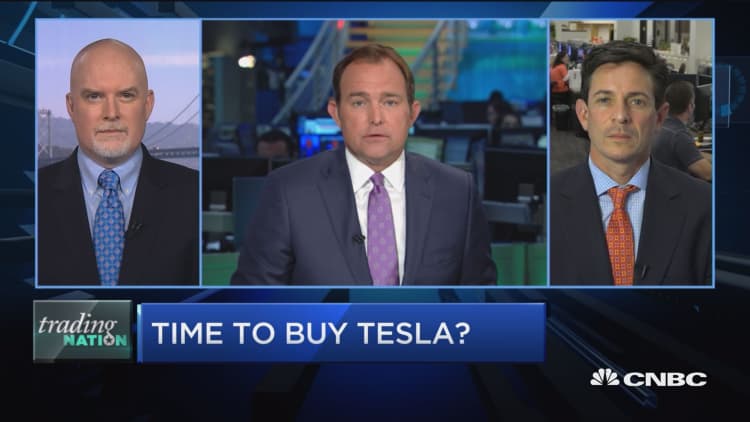
Tesla has analysts throwing up their hands.
Bernstein analyst Toni Sacconaghi reiterated his market perform rating and $265 price target on Wednesday, explaining that "we worry about whether Tesla can successfully build the mass-market Model 3: (1) with good gross margins, (2) with good quality, and (3) on time."
He also pointed out that Tesla "appears to be the largest public company in history to have never generated either positive annual cash flow or positive annual profit."
It might sound a little odd that Sacconaghi pairs a neutral rating on the stock with a price target that implies a 24 percent decline from Wednesday's opening price. But it is important to note the broader context, which is that Tesla is a notable volatile and highly speculative name that leaves analysts sharply divided.
Just 29 percent of research analysts rate the stock a buy or the equivalent, according to FactSet data; 33 percent rate it hold and 38 percent say sell.
Target prices published in the last three months on the now-$348 stock are as low as $170 and as high as $464.
That $170 figure comes from Cowen analyst Jeffrey Osborne, who actually increased his target from $155 in an Aug. 3 research note. Indeed, the metaphor-mixing title of that note conveys some of the difficulty of calling Tesla's next move: "Lots of Moving Pieces to Chew On; Reiterate Underperform."
Like Sacconaghi, Osborne worries about the Model 3, writing that he and his team "continue to be cautious on the stock, especially as the risk profile shifts from the hype of the Model 3 to execution, or 'production hell' as Elon Musk refers to it."
What's most striking about Osborne's call, however, is just how optimistic the estimates of this Tesla bear appear to be. His $170 price target is based on what he thinks 2020 will look like — he expects the company to earn non-GAAP earnings of $7.38 per share on revenue of about $24 billion, and for the company to trade about 23 times that earnings number.
This 2020-centric number is not then discounted back to the present, meaning it does not account for the risk that Tesla may not manage to more than double its revenue, or that investors may then fail to pay an above-market multiple on a earnings number that ignores the company's hefty share-based compensation.
In an email, Osborne explained that "we typically discount as part of the P/E," implying that he actually expects the price-earnings ratio to be significantly higher than the stated 22 to 24 times range.
The highest $464 price target comes from Berenberg analysts, who lifted their Tesla target from $193 in a long June note on the auto sector. Berenberg analyst Alexander Haissl wrote that there is "no realistic threat in sight" for the stock. "Tesla's competitive advantage in the product itself, the manufacturing process and footprint will likely allow it to gain unencumbered market share for a longer period than expected, helping to elevate long-term profitability," he wrote.
Haissl's valuation is based largely on an estimate of what the company's cash flow picture will look like in 2030, and he explicitly writes: "near term unimportant."
Still, Haissl expects that the company will enjoy sales of $65 billion in 2020, more than double Osborne's number, and 1½ times Sacconaghi's.
In other words, future revenues are very much up in the air. And no matter how analysts value the stock, they are forced to peer far into the future to come up with their target price. Indeed, that is really the only way to make projections about a company that is persistently losing money.
No wonder the stock has proved so divisive — among analysts and investors alike.






